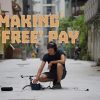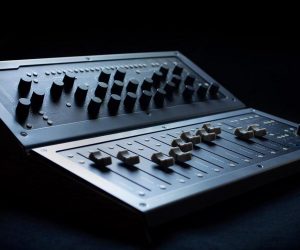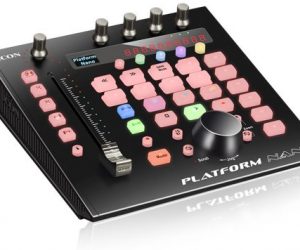
Band Fade Solution
Matt Corby made a commitment to go completely DIY in five years. Rainbow Valley, which he played and sang solo, is a big step in that direction.
Matt Corby’s next record may well be a completely self-produced affair. “I’ve always been heading that way,” he said. “It started pre-Telluric. I did this album in LA with my band and a couple of epic producers. A few too many people got involved, and it ended up being total dog s**t.”
He came home from that experience and decided he would take the next five years to learn how to do everything himself. It was too soon for his debut album, Telluric, to show much fruit of that labour. It was recorded rather traditionally: a full band in Sing Sing Studios, with producer Dann Hume and engineer Matt Neighbour at the helm.
Since then, Corby committed to practising a range of instruments and learning to play the drums properly. A few years of this ultra-private music school gave him enough confidence to tackle the next hurdle in his DIY plan; recording every single instrument on Rainbow Valley. “It felt like it could work this time. That I could do everything myself, but not have it sound too much like it was just me,” explained Corby. “When I was younger, guitar and piano were just there to facilitate my singing. Now it’s kind of the opposite. The singing facilitates me having fun in the studio. When something comes to life and is working, it’s like being on drugs. It feels great to hear something that was originally just white noise, come together into a bunch of cool moving elements and production.”
NOT COMPLETELY SOLO, YET
He still relied on a few helping hands. Long-term collaborator, Alex Henrikkson, helped him jam up a ton of ideas in the early stages. “I spent probably eight months with Alex. He’s one of my close mates who I write with a lot,” said Corby.
“We’d spend about four or five days at a time experimenting in my home studio. There were so many jams — there’s a folder of about 80 tracks sitting in my iTunes — and a few of them turned into songs.”
Matt Neighbour was also back in the picture. He helped Corby set up his home studio in his old place on the South Coast of New South Wales. “It was a bungalow where he and Dann had done a lot of the vocals for Telluric,” said Neighbour. “He had a couple of BAE Neve pres, but not many mics. Then we ordered a pair of Coles ribbons, a pair of Chandler TG 500 series preamps and a pair of API 500 series pres.
“When he moved up to Byron, we set it up so everything was, more or less, ready to go all the time. We slowly added a few things when I saw a used piece pop up for sale. We got a UA 1178 compressor and a dbx 165 from Italy that was barely used. At some point he got a Distressor, and a bunch of cool dynamics mics; a Sennheiser 421 and a 441. Then a pair of old AKG 414s, which we used on the pianos.”
Corby also has a ’70s Ludwig kit, and a bunch of synths. The studio is “a separate dwelling to the house, just dedicated to making music,” explained Corby. “Eventually my goal is to build a proper studio out the back. I’d like to get to a point where there’s a hub for people who want to make records.”
It felt like it could work this time. That I could do everything myself, but not have it sound too much like it was just me
STOKED ON RAINBOW VALLEY
The album title is lifted from Corby’s spacious plot — north of Byron in Stokers Siding — which the previous owner named Rainbow Valley. “It’s fitting because nothing would have been made without this place,” said Corby. “Just being able to have my own studio space, peace and quiet, and no neighbour close by to disturb. Songwriting is so funny; it’s kind of like playing the lottery. On any given day, you can come across something that’s hecticly amazing or something that’s utter s**t. It can come down to the conversation you had the night before or the fact you only had one piece of bacon for breakfast. Any little thing can change how your body is operating, or how your mind feels. This place facilitated me making this record.”
After hanging a few sheets of Tontine to tame the top end, Corby and Neighbour took those Logic demos and started fleshing them out into actual songs. Figuring out the arrangements and recording them properly. Three of those songs ended up on the record — Light My Dart Up, Get With the Times, and Rainbow Valley.
After that, Corby and Hume went to Music Farm. It’s one of Byron’s famous home-based studios which was brought back to life a couple of years ago and loaded with a lot of Wayne Connelly’s gear, including “a f**k off $300,000 Neve that sounds stupidly good,” said Corby. “It was Dan’s call. I think it was the hi-fi-ness in him. He just wanted to record the s**t out of this music. It was nice going to a super dry room and hearing different mics going through a different desk. It definitely puts you in a different mood and brings out different stuff when you’re recording.”
He and Hume co-wrote much of the album together over a month. “We did about two songs a day, then every now and then we hit a good one and would polish it up,” said Corby. “It was pretty quick fire songwriting.”
After that, Neighbour came back into the picture. The three of them polished up all of the songs at Music Farm, including the three from Corby’s studio, and pulled the final album together.
For most of the record it was just Corby and one other person in the room at a time. “It’s pretty good with two people, because you don’t have to consider anyone else’s day or feelings,” said Corby. “You could just say, ‘that sounds like s**t, I’m going to change it.’ Or jump on drums again. Whatever is necessary. We had a general direction of what sound and tone we wanted from each instrument.
“I’ve never been in that sort of situation where it’s just run so unanimously and smooth, where we all knew when we were hitting the vibe and objectively agreed on things sounding good.”
“It wasn’t necessarily conscious,” agreed Neighbour. “The deeper we got into the record, the stronger the existing palette felt.”
TAKE IT AS IT COMES
Neighbour credits Corby’s musicality, not any studio tricks, as the key to pulling off the one-man band effect. “The time between him picking up an instrument and sounding musical is really quick,” said Neighbour. The rest is just about listening to what he’s doing and picking out the best bits, which Neighbour reckons comes from the first take 90% of the time. “He’s not the kind of person to plan out the drum patterns and then do 10 takes of roughly the same thing. If he’s got an idea, you’ll get it once and then not again. His instincts are so strong, you have to be careful not to dismiss what he was doing before he was thinking about it.
“When you have one person playing all the instruments, the goal is to have it sound like a group of people playing well together. So you want a part that’s got his character, but you also want it to be restrained enough that it sounds like someone who’s listening to his surroundings. That’s usually why the first take is so good, because he’s playing and adding flair based on his instincts but ultimately he’s still listening to the track and figuring out where the space is.”
HOME-MADE MELLOTRON
Those instincts led Corby to chase a vibe that was new soul, but “without much stereotypical soul in it.” Dirty Art Club’s Basement Seance was a big inspiration for Corby. “I don’t normally get that attached to records. It kind of sounds like a Tarantino film; new soul, but with all these samples on it.” Corby had an even deeper objective, he was “aiming for the stuff that gets sampled in hip hop. Where everything is its own new sample but gets created from scratch.”
A big part of that was finding a balance between his penchant for lo-fi and Hume’s ability to pull “super-duper hi-fi sounds. The combination of our tastes works harmoniously,” said Corby.
“With a lot of the instruments, the thing you would associate with lo-fi was more the pitch modulation, wow and flutter, and graininess,” said Neighbour. “A lot of that was there in the palette of sounds, rather than the process of recording.”
Sometimes that simply played out organically, like with the piano recordings. “Matt’s piano has a lot of chorus because certain strings are out of tune, and there’s a lot of hammer noise. The piano at Music Farm was pretty similar. It’s a European piano that’s probably 150 years old, and although it’s in tune, there’s a lot of stretch in the notes. Whether you record it with a couple of Neuman U67s, which we often did, or an old broadcast mic, either way it’s going to sound lo-fi.”
Other times, that meant recreating the character of old machines. There’s a lot of Mellotron on the record, but when they were recording the opening track they didn’t have access to a real one at Corby’s studio. Instead, they made their own. “Matt plays flute, so he played the parts,” recalled Neighbour. “Then I went through and cut up all the organic notes and looped the waveforms so they were in blocks and played like a keyboard. That way it sounded like it was note on, note off, rather than stopping for breaths. Then I ran all that through a tape delay without any delay for a lo-fi effect. We would never have got the same result if Matt was playing keyboard. He would have played something very different to three harmonised flute parts.”
He’s got an amazing range not only pitch-wise, but dynamically. When he hears a compressor clamp down, it’s almost like he loses his place
GROOVIN’ IN MONO
“The emphasis wasn’t on ultra-clean studio recording,” said Neighbour. “It was always earthy and about capturing the character.”
That’s why mono drum recording techniques formed the core of the record’s rhythm sound. It not only fit the aesthetic, but also suited how Corby plays drums. “There’s not a lot of separation in his playing,” explained Neighbour. “His sound depends on a lot of the sympathetic energy between the drums. He’ll dig into the hats when he hits the snare. When he hits the tom, it’ll be going into a snare roll. Everything is really gritty and together, so a simple, compressed setup brings out the best in the style of playing that’s already there.”
The mono mic used during the Music Farm sessions was often Neighbour’s vintage Australian-made Zephyr ribbon placed over the kick drum, pointing at the snare; equal parts between the rack tom and the ride.
At Corby’s studio, it was common to find a Sennheiser MD421 tucked up under the rack tom pointing upwards, looking at the bottom snare, and running through a Distressor in Brit Mode. “When he hit the tom, the snare would ring, and the kick and snare would distort well from that position,” said Neighbour. “On songs like No Ordinary Life and All Fired Up, the drums were from Matt and Dann’s original demo sessions at Music Farm. Some of those sounds were just an omni U67 in the spot in the room where it was used on vocals, maybe nudged a bit closer to the kit and compressed with the dbx 165, or sometimes even just Soundtoys’ Devil Loc. Dann would then add a kick sample in later.”
The drum grooves also dictated the entire palette of the record. “On a song like No Ordinary Life, it has such a busy groove that it lends itself to be played with low attack instruments like Mellotrons and pads,” said Neighbour. So despite Corby’s reliance on guitar for much of his career, there’s barely any on Rainbow Valley. “We kept thinking, ‘oh maybe Wednesday, we’ll do some guitar.’ Then it became, ‘oh, maybe Sunday,’” recalled Matt. “The grooves cover a lot of rhythm already, so there just wasn’t a big need for other instruments like guitars to fill that role. It became a lot of piano, harp, flute, horn, and taped keys samples.”
OMNI PRESENT VOCALS
Most of the vocals on the record were done with one of the Neumann U67s at Music Farm. It would be set in an omni pickup pattern, with no pop filter or compression, and Corby standing two or three feet from the mic. “He had headphones on, and would move around and closer during the intimate sections,” explained Neighbour. “Getting to that point was a long process. We had to develop a way of recording that showcased his tone but also allowed him to deliver really dynamic performances. He’s got an amazing range not only pitch-wise, but dynamically. When he hears a compressor clamp down, it’s almost like he loses his place. Imagine driving a car and suddenly the windshield goes black, then clearing up again but you don’t know where you are. Compressors make him lose his point of reference.
“We did a similar thing with Telluric with an AEA ribbon mic and no pop filter, just letting him move around the room and react to the mic so he can be his own compressor.
“Moving to an omni was the final touch, because unlike directional patterns, it doesn’t have a sweet spot for your tone as long as you have a good sounding room. That room at Music Farm sounds really balanced. Loud sounds return a nice bottom end bump, which is the opposite of what I’ve found in rooms with with similar dimensions.
“Even from a physical point of view, it helps Matt get really into it. The outro of the song Elements, where he’s letting rip. He’d be back a metre and a half from the mic and singing up towards the roof, but the room sounds good enough to capture it well.
“Most of the vocals I did with Matt were done with a Shure SM7 at his place, or a Gefell tube mic I had. They were done more traditionally with a close cardioid, but those songs are also not the dynamic ones; they’re the softer, tender moments.”
BACKSEAT PRODUCER
Corby hasn’t quite reached the point of complete self-sufficiency. It might take a little longer than his five-year plan, but he’s actively pursuing his production education. Even if it’s mostly over-the-shoulder of Hume and Neighbour. “I’m super novice, but I was just over Dann’s shoulder every day asking, ‘What’s that plug-in? What are you doing there?’ Said Corby. “He’d get so annoyed and started pulling his plug-ins up and doing something really quick so I couldn’t even ask.”
Neighbour likes Corby’s enthusiasm but thinks part of the reason he’s such a good artist is precisely because “he doesn’t think in the ways you do when you spend all your time in Pro Tools or Logic. He can think about music more freely than most producers and engineers I know.”
Still, Corby plans to battle on with it. We’ll see how far he’s come next record. “I’m getting better and better at producing,” reckoned Corby. “Hopefully there’ll be something I put out there in the next couple of years that I’ll be happy with.”












![201805_MattCorby_MattJohnson_RainbowValley_MG_5455_[PRINT]](https://www.audiotechnology.com/wp-content/uploads/2019/10/201805_MattCorby_MattJohnson_RainbowValley_MG_5455_PRINT.jpg)
![201805_MattCorby_MattJohnson_RainbowValley_MG_5407_[PRINT]](https://www.audiotechnology.com/wp-content/uploads/2019/10/201805_MattCorby_MattJohnson_RainbowValley_MG_5407_PRINT.jpg)
![201804_MattCorby_MattJohnson_RainbowValley_MG_3277_[PRINT]](https://www.audiotechnology.com/wp-content/uploads/2019/10/201804_MattCorby_MattJohnson_RainbowValley_MG_3277_PRINT.jpg)
![201804_MattCorby_MattJohnson_RainbowValley_MG_3260_[PRINT]](https://www.audiotechnology.com/wp-content/uploads/2019/10/201804_MattCorby_MattJohnson_RainbowValley_MG_3260_PRINT.jpg)
![201804_MattCorby_MattJohnson_RainbowValley_MG_3115_[PRINT]](https://www.audiotechnology.com/wp-content/uploads/2019/10/201804_MattCorby_MattJohnson_RainbowValley_MG_3115_PRINT.jpg)













RESPONSES